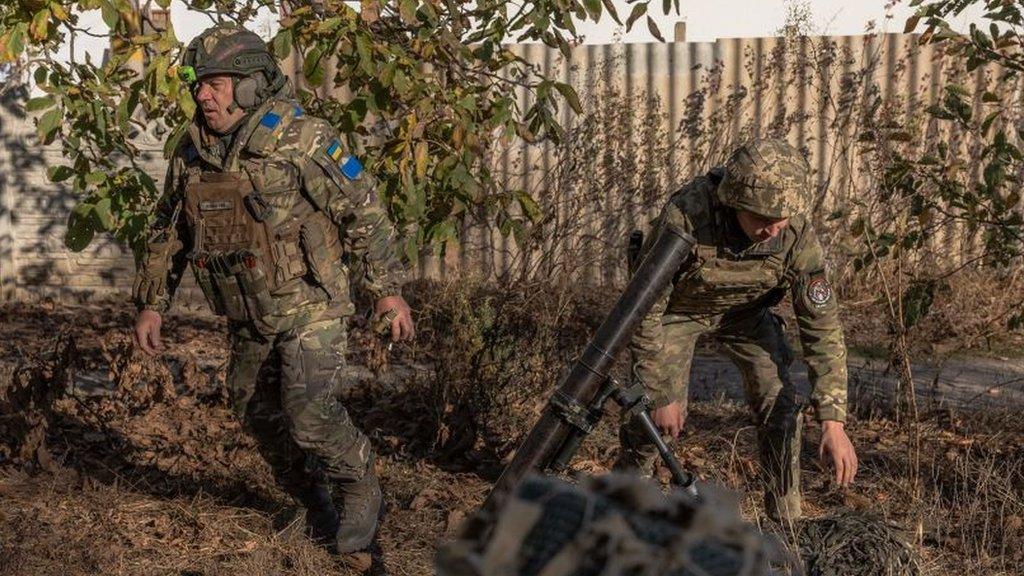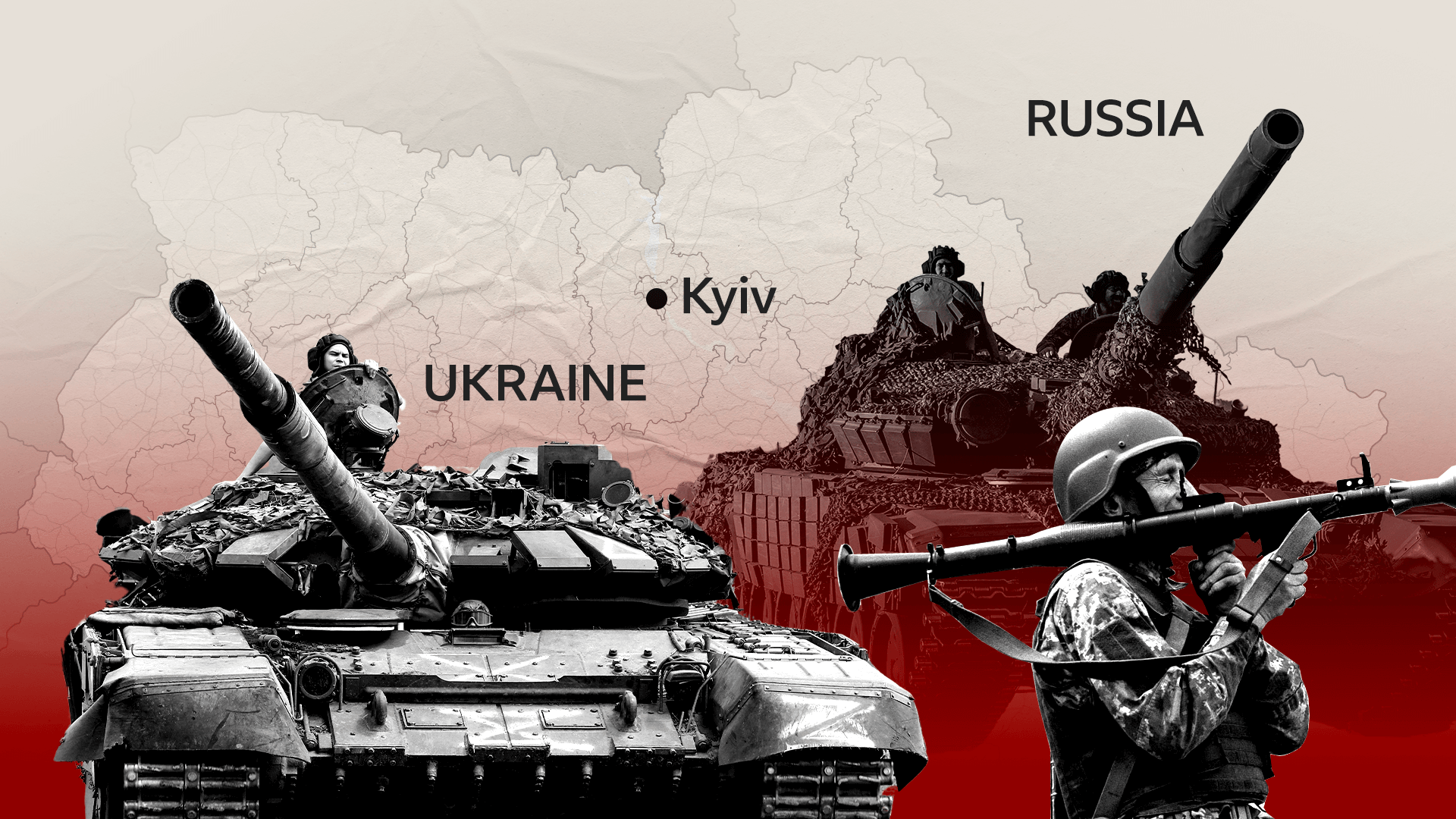Ukraine war: Marines gain riverbank foothold but front lines barely move
- Published

Ukraine's president posted pictures of Ukrainian marines, saying they were moving forward on the left bank of the Dnipro
Ukrainian forces say they have secured several positions on the Russian-occupied eastern bank of the Dnipro river, and their leaders have been keen to talk up their progress.
The marines have spoken of gaining a foothold on "several bridgeheads" on the left bank, as they try to push the Russians back in a bid to protect civilians on the opposite side of the river from constant Russian shelling.
"Thank you for your strength, for moving forward," President Volodymyr Zelensky announced on social media on Friday, alongside pictures of marines arriving in small boats.
The few hundred soldiers are outnumbered and surrounded in three directions, yet have managed to dig in for the best part of a month. This isn't the thousands needed to potentially liberate swathes of territory which Kyiv so desperately wants to do.
The front line has barely moved for a year and Ukraine finds itself in a tricky cycle. It needs Western help to deliver battlefield progress, but it also needs battlefield progress to convince western helpers.
General Valerii Zaluzhnyi, the head of Ukraine's armed forces, has described the situation as a stalemate and says a number of innovations are needed to break it.
President Zelensky has dismissed his view, and believes Ukraine can still be victorious.
Their argument has fuelled political fatigue among some of Ukraine's Western allies.
The south is one area where the mood is high.
A year ago, the southern Kherson region was seen as the least likely place for Ukraine to mount its counter-offensive.
For the Russians, there is no better defensive line than a huge body of water like the Dnipro river. It separates the third of the region liberated last year from the two-thirds still under occupation.


Ukrainian armoured vehicles have advanced 4km (2.5 miles) and Kyiv is framing these inroads as the start of something bigger.
"We are motivated by our families and we get decent financial support," one special forces fighter told the BBC.
The reality is there are simply not enough boots on the ground yet to justify Kyiv's hopes for a breakthrough there.
In the south-east, Ukrainian troops have thrown everything at trying to retake territory there, but have only liberated a handful of villages.
"Fatigue is the main thing, and it kills any motivation," explains a soldier with a mortar crew in the Zaporizhzhia region.
He's fighting with the 46th brigade in an area where Russian defences are at their strongest.
"We've killed many Russians, but lost no fewer," says the soldier. "Anyone who complained was removed from their position."
During the summer, this part of the front line was seen as the best place for Ukraine to try to break the land corridor Russia occupies in two.
Now, Western officials think neither side can mount a land offensive "in the near future". As far as they're concerned, it's a stalemate.
The soldier in the 46th Brigade believes next year will be difficult, but decisive: "It is impossible to fight forever. Hatred is soon replaced by apathy."

A Ukrainian soldier watches over a position on the Dnipro river, where raids by Kyiv's forces have been intensifying in recent weeks
It is on the eastern axis that Russian forces have been pushing hardest, and it is the city of Avdiivka that best reflects the state of this war.
It was briefly occupied in 2014 before being liberated, and the Russians have been trying to get it back since.
Ukraine has recently been repelling wave after wave of attacks, partly helped by the heavy fortifications it has built over the past nine years.
Western officials say Russia is suffering 500-1,000 casualties a day there.
"Our commanders and fighters have studied every hill and every road," says Ivan from Ukraine's 110 Brigade. He's been serving there since March 2022.
Avdiivka's strategic value is questionable, but clearly Kyiv thinks it's inflicting a significant enough number of losses compared to its own.
The mood can be described as "fatigue, rage and desire to expel evil", explains Ivan. "It's tiredness from the constant threat to your life, not from the front line not moving.

Ivan from 110 Brigade speaks of a mood of fatigue from the constant threat from Russian forces
In the north-east, more than 250km (155 miles) to the north, the city of Kupiansk was occupied for most of last year until Ukraine's counter-offensive last autumn.
As an important railway hub, Kupiansk has strategic value and during this war both sides have used it to supply the front lines.
Civilians were urged to leave in August because of constant shelling as Russia tried to take it back.
Denys is at the very sharpest edge of the fighting and after months on the front line he has had enough, complaining that his commanders do not listen to advice.
"They emphasise aviation and artillery, but we need the latest technologies, like drones," he says.
He believes Nato, which Ukraine desperately wants to join, needs to learn lessons from this very modern war.
Mines are one of the biggest challenges for Ukrainian troops across the frontline.
"The Russians have machines that can mine an area of tens of kilometres per day," explains Denys. "They use anti-personnel mines, anti-tank mines, they lay three mines, one under the other."
Another hurdle has been the quality of Russian defences, which Denys describes as "underground cities".
From his position, as a rank-and-file soldier on the front line, Denys has seen a horrifying human cost on his own side of the incremental breakthroughs in recapturing territory. "The commander throws anyone - cooks or drivers - into the furnace. They simply die there in their hundreds."
"Those commanders will have to be arrested and tried after the war," he says.
These soldiers on Ukraine's front lines reflect the war of attrition this invasion has become. With its size and resources, that suits Russia.
What Kyiv is also having to grapple with, is sharing the spotlight with another conflict: the Israel-Hamas war.
President Zelensky has admitted it makes Ukraine's fight all the more difficult, with the risk of Western attention and aid being diluted.
Additional reporting by Anastasiia Levchenko and Hanna Tsyba.
Related topics
- Published15 November 2023

